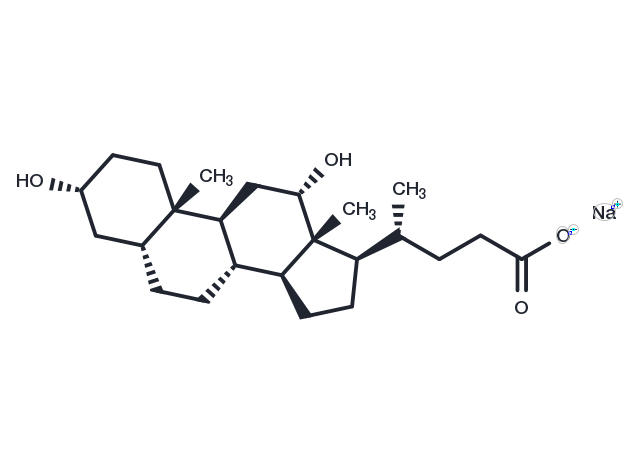keep away from direct sunlight
Powder: -20°C for 3 years | In solvent: -80°C for 1 year

Deoxycholic acid sodium salt (Sodium deoxycholate) can activate the G protein-coupled bile acid receptor TGR5 that stimulates brown adipose tissue (BAT) thermogenic activity.

| Pack Size | Availability | Price/USD | Quantity |
|---|---|---|---|
| 50 mg | In stock | $ 38.00 | |
| 100 mg | In stock | $ 54.00 | |
| 500 mg | In stock | $ 76.00 |



| Description | Deoxycholic acid sodium salt (Sodium deoxycholate) can activate the G protein-coupled bile acid receptor TGR5 that stimulates brown adipose tissue (BAT) thermogenic activity. |
| In vitro | Deoxycholic acid (DCA) and chenoDeoxycholic acid (CDCA) are the common ingredients of duodenal reflux that act synergistically in many physiological and pathological processes. The cells are repeatedly exposed to 100 μM CDCA and Deoxycholic acid at pH 5.5 for up to 120 min. To simulate chronic local recurrent disease in vitro, the gastric cancer cell line MGC803 is exposed to acidified medium (pH 5.5) containing 100 μM Deoxycholic acid and CDCA. An untreated log-growth MGC803 cell line is generated to be used as a control in normal pH media. After daily 10 min exposure to the acidified bile acids for 60 weeks, MGC803-resistant cells are able to survive and proliferate after 120 min exposure [2]. |
| Cell Research | MGC803 cells are cultured in Roswell Park Memorial Institute media supplemented with 10% fetal calf serum and 100 U/mL Penicillin and 100 mg/mL Streptomycin. To generate MGC803-resistant cells, the pH value of the MGC803 culture medium is adjusted to the experimental conditions using the hydrochloric acid (A). The bile acids GCDA and Deoxycholic acid are diluted to optimal working concentrations of 100 μM (B) with culture medium, and the overall pH (A+B) is adjusted to pH 5.5, simulating the gastric environment. Initially, MGC803 cells are chronically exposed to acidified medium with bile acids (A+B) for 10 min every 24 h. The experimental time and conditions are optimized in our preliminary experiments, which show that 10 min is enough and does not result in cell damage. This procedure is repeated and it takes 60 weeks for the MGC803 cells to survive and proliferate under the exposure of A+B for 120 min. Control untreated cells are cultured in neutral RPMI medium at pH 7.4 in parallel to the resistant cells for 60 weeks. The morphological changes in MGC803 cells exposed to acidified bile acids (A+B) are documented at 30 and 60 weeks[2]. |
| Synonyms | Sodium deoxycholate, Sodium Desoxycholate |
| Molecular Weight | 414.56 |
| Formula | C24H39NaO4 |
| CAS No. | 302-95-4 |
keep away from direct sunlight
Powder: -20°C for 3 years | In solvent: -80°C for 1 year
H2O: 330 mg/mL
DMSO: 12.5 mg/mL (30.15 mM)
You can also refer to dose conversion for different animals. More
bottom
Please see Inhibitor Handling Instructions for more frequently ask questions. Topics include: how to prepare stock solutions, how to store products, and cautions on cell-based assays & animal experiments, etc.
Deoxycholic acid sodium salt 302-95-4 GPCR/G Protein Metabolism GPCR19 Endogenous Metabolite Inhibitor G-protein coupled receptor 19 bile acid TGR5 Deoxycholic acid G protein-coupled bile acid receptor GPBAR1 Deoxycholic acid sodium G protein-coupled Bile Acid Receptor 1 inhibit Sodium deoxycholate Sodium Desoxycholate inhibitor
